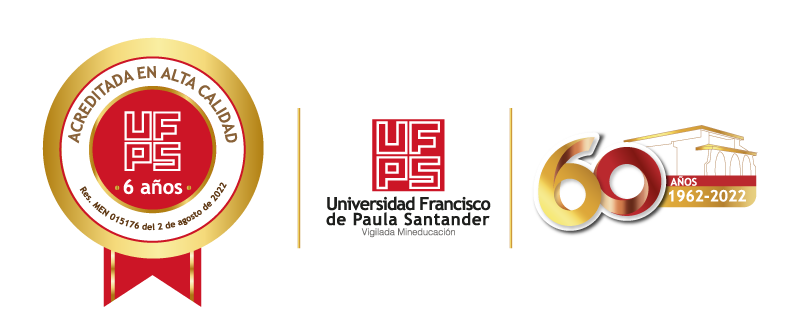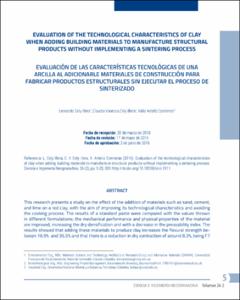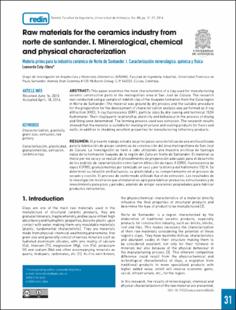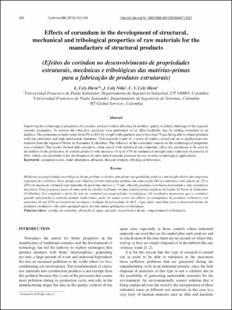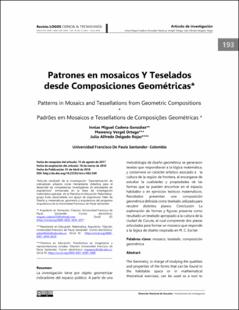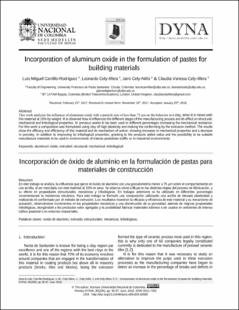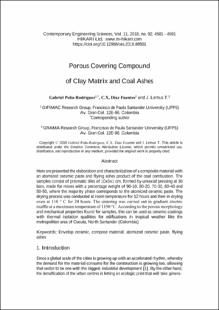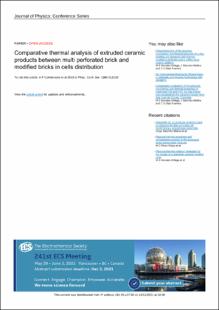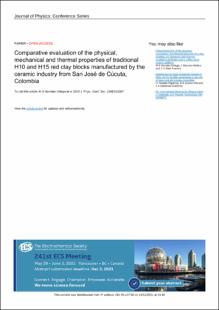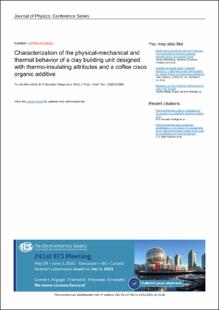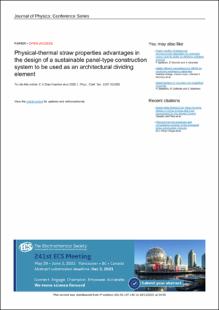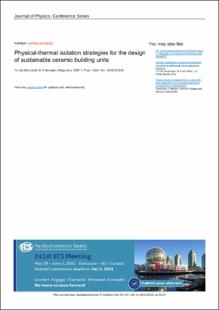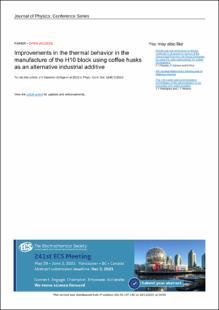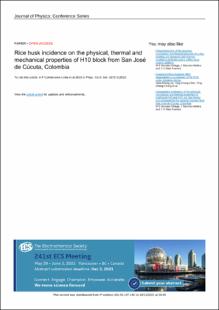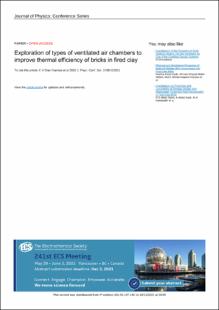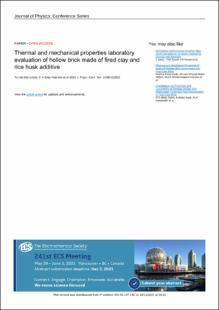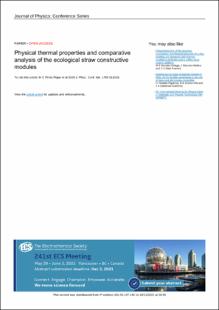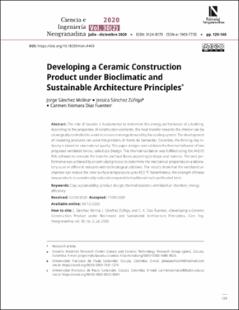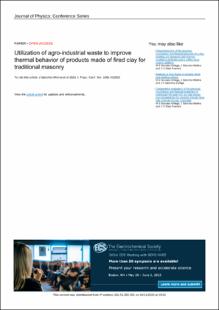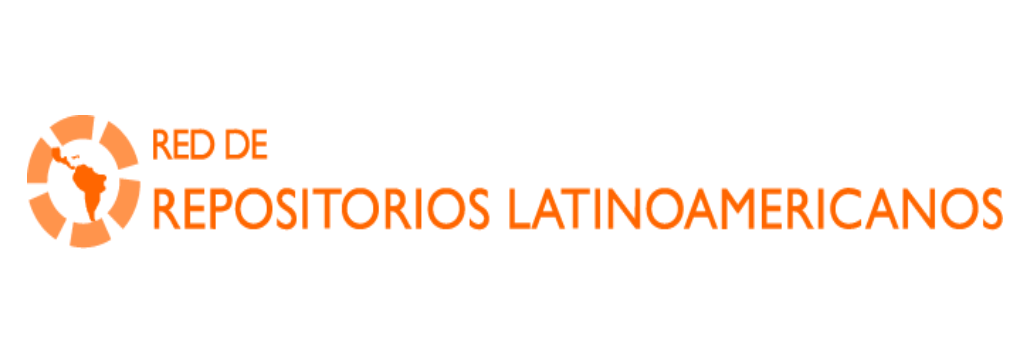Listar Arquitectura y Materiales Alternativos – GRAMA por fecha de publicación
Mostrando ítems 1-20 de 20
-
Evaluación de las características tecnológicas de una arcilla al adicionarle materiales de construcción para fabricar productos estructurales sin ejecutar el proceso de sinterizado
(Ciencia E Ingeniería NeogranadinaColombia, 2016-08-01)This research presents a study on the effect of the addition of materials such as sand, cement, and lime on a red clay, with the aim of improving its technological characteristics and avoiding the cooking process. The ... -
Raw materials for the ceramics industry from norte de santander. I. Mineralogical, chemical and physical characterization
(Revista Facultad de IngenieriaColombia, 2016-09-15)This paper examines the main characteristics of a clay used for manufacturing ceramic construction parts in the metropolitan area of San José de Cúcuta. The research was conducted using a sample of reddish clay of the ... -
Effects of corundum in the development of structural, mechanical and tribological properties of raw materials for the manufacture of structural products
(CeramicaBrasil, 2018)Improving the technological properties of a ceramic product without affecting its aesthetic quality is a daily challenge of the regional ceramic companies. To achieve this objective, analyzes were performed on an ... -
Patrones en mosaicos Y Teselados desde Composiciones Geométricas
(Logos Ciencia & TecnologíaColombia, 2018-03-20)La investigación tiene por objeto geometrizar indicadores del espacio público. A partir de una metodología de diseño geométrica se generaron teselas que respondieran a la lógica matemática, y conservara un carácter ... -
Incorporation of aluminum oxide in the formulation of pastes for building materials
(Revista DynaColombia, 2018-04-01)This work analyzes the influence of aluminum oxide with a particle size of less than 75 μm on the behavior in a clay, when it is mixed with this material at 10% by weight. It is observed how it influences the different ... -
Porous covering compound of clay matrix and coal ashes
(Contemporary Engineering SciencesBulgaria, 2018-11-05)Here are presented the elaboration and characterization of a composite material with an atomized ceramic paste and flying ashes product of the coal combustion. The samples consist of prismatic tiles of 10x5x1 cm, formed ... -
Comparative thermal analysis of extruded ceramic products between multi perforated brick and modified bricks in cells distribution
(Journal of Physics: Conference SeriesReino Unido, 2019-10-23)The demand for cooling and heating systems to adapt spaces is a critical environmental problem due to the high energy consumption required for its operation. For this reason, the offer of products for architectural facades ... -
Comparative evaluation of the physical, mechanical and thermal properties of traditional H10 and H15 red clay blocks manufactured by the ceramic industry from San José de Cúcuta, Colombia
(Journal of Physics: Conference SeriesReino Unido, 2019-11-19)The traditional blocks of baked clay represent 15% of the total production of the ceramics cluster in the Norte de Santander region, with a product typology whose dimensions, shape, weight and price are the most demanded ... -
Characterization of the physical-mechanical and thermal behavior of a clay building unit designed with thermoinsulating attributes and a coffee cisco organic additive
(Journal of Physics: Conference SeriesReino Unido, 2019-11-29)This research is articulated from the clay framework as material wealth of the region of Norte de Santander, Colombia, and seeks to structure attributes of passive thermal cooling in a ceramic piece for low cost masonry ... -
Physical-thermal straw properties advantages in the design of a sustainable panel-type construction system to be used as an architectural dividing element
(Journal of Physics: Conference SeriesReino Unido, 2020-08-05)The walls in architecture determine the energy behavior of a home, the physical and thermal properties of the building elements are capable of controlling the energy transfer of to the interior, avoiding dependence on ... -
Physical-thermal isolation strategies for the design of sustainable ceramic building units
(Journal of Physics: Conference SeriesReino Unido, 2020-09-30)The architectural envelope constitutes more than the aesthetic expression of the building, currently it represents one of the most important challenges in the configuration of energy efficiency in buildings, the materials ... -
Improvements in the thermal behavior in the manufacture of the H10 block using coffee husks as an alternative industrial additive
(Journal of Physics: Conference SeriesReino Unido, 2020-09-30)Industrial organic waste reuse in product manufacturing processes is a strategy that strengthens the circular economy. Thanks to materials science, the coffee husk is considered a sustainable alternative that promotes ... -
Rice husk incidence on the physical, thermal and mechanical properties of H10 block from San José de Cúcuta, Colombia
(Journal of Physics: Conference SeriesReino Unido, 2020-11-04)The generation of new building materials responds to the reduction of energy consumption and regulation of building interior temperatures as strategy to improve energy efficiency in materials engineering and architecture. ... -
Exploration of types of ventilated air chambers to improve thermal efficiency of bricks in fired clay
(Journal of Physics: Conference SeriesReino Unido, 2020-12-05)The products and construction systems for facades regulate energy transfer in the architectural envelopes. Therefore, this paper developed an exploration of types of ventilated air chambers to improve thermal efficiency ... -
Thermal and mechanical properties laboratory evaluation of hollow brick made of fired clay and rice husk additive
(Journal of Physics: Conference SeriesReino Unido, 2020-12-05)Hollow bricks in fired clay for masonry are important in design and construction of buildings. Their thermal and mechanical properties must be considered because of the impact they have on energy consumption. The objective ... -
Physical thermal properties and comparative analysis of the ecological straw constructive modules
(Journal of Physics: Conference SeriesReino Unido, 2020-12-05)Understanding the physical and thermal material properties is important, due to it helps to determine the thermal comfort and how green is an architectural space, decreasing the energy consumption and avoiding the use ... -
Developing a Ceramic Construction Product under Bioclimatic and Sustainable Architecture Principles
(Ciencia e Ingeniería NeogranadinaColombia, 2020-12-09)The role of facades is fundamental to determine the energy performance of a building. According to the properties of construction elements, the heat transfer towards the interior can be strategically controlled to avoid ... -
Algalcolor: bio-platform for the sustainable production of cyanobacterial-based colours and fine chemicals
(Universidad Francisco de Paula SantanderCúcuta, 2021)Las cianobacterias son consideradas como una de las nuevas fuentes biotecnológicas sostenible de varias materias primas para la industria farmacéutica, alimentaria, clínica y energética mundial. Dentro de estos metabolitos, ... -
Utilization of agro-industrial waste to improve thermal behavior of products made of fired clay for traditional masonry
(Journal of Physics: Conference SeriesReino Unido, 2021-08-09)The reutilization of agro-industrial waste in the manufacture of fired clay products is a sustainable strategy that aims at the circular economy. The most known waste in Norte de Santander, Colombia, are coffee husk and ... -
Utilization of agro-industrial waste to improve thermal behavior of products made of fired clay for traditional masonry
(Journal of Physics: Conference SeriesReino Unido, 2021-08-09)The reutilization of agro-industrial waste in the manufacture of fired clay products is a sustainable strategy that aims at the circular economy. The most known waste in Norte de Santander, Colombia, are coffee husk and ...
